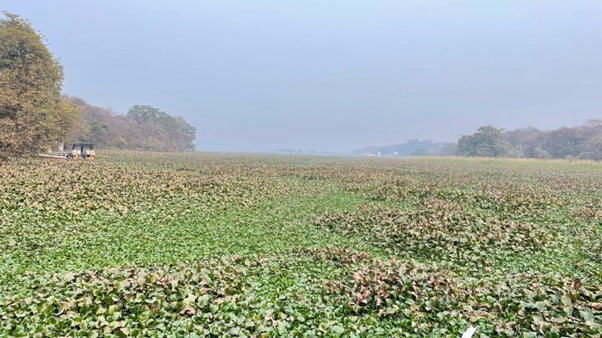Environment & Ecology
In News: An artificial lake in Madhya Pradesh’s Shivpuri district has virtually disappeared under a thick layer of an invasive aquatic plant, threatening the biodiversity of the water body.
Water hyacinth

- Water hyacinth (Pontederia crassipes) is an invasive species native to South Africa.
- The plant has naturalised itself in many other parts of the world.
- While the plant has some uses too, when it covers the entire surface of a water body, it becomes a threat to aquatic biodiversity.
- Macrophytes like water hyacinth can’t be outrightly placed in a harmful or useful category
- Water hyacinth acts as a water purifier by removing heavy metals from water when present in small quantities.
- However, the plant is a prolific spreader and when it covers the entire surface of a water body, it does not allow sunlight to penetrate the water and also starts depleting oxygen.
- This leads to death of aquatic animals and plants, which in turn decompose and further reduce oxygen levels
- The presence of water hyacinth indicates that there are high nitrogen levels in the water
- It is a symptom of an underlying problem and how the water nutrients behave.
- It also indicates a lack of effective competing factors to prevent its growth.
The Sankhya Sagar
- It was declared a Ramsar site in July 2022.
- The lake spreads across 248 hectares (612.82 acres) with a catchment of 37,522 ha and helps maintain the ecological balance of the Madhav National Park.
- As a Ramsar site, it is a wetland site designated internationally important by the United Nations Educational, Scientific and Cultural Organization.
- Sankhya Sagar supports significant populations of 19 indigenous fish species, which spawn and breed in its habitat
- The water body has a mix of riverine and palustrine (marsh) habitat fish populations, making them critical to maintaining the overall biodiversity of the region.
- The fish species, in turn, support the population of piscivorous (fish-eating) birds.
- Waterfowls are also present here in large numbers.
- The lake is home to 73 species of birds and welcomes migratory birds during winter.
- The lake is also home to marsh crocodiles aka ‘Mugger’ (Crocodylus palustris) is a Schedule I reptilian species protected under the Indian Wild Life (Protection) Act, 1972.
- The reptiles were introduced in Jadhav Sagar in 1987 by the Madras Crocodile Bank.
- The northern side of the water body is a hilly area and several minor drains join it.
- The Maniyar river connects the Sankhya Sagar to another lake, Jadhav Sagar, which passes through the national park.
- The lake’s western side is downstream and has a dam line — a barrier to control water levels.
- The water flows through the spillway towards another waterbody, the Madhav Sagar lake. Both Jadhav Sagar and Madhav Sagar are also covered in water hyacinths.
- Sankhya Sagar falls under the forest department and can only be cleaned with the efforts of the director of Madhav National Park.
Source DTE
Previous Year Questions
Q1) Which of the following can be threats to the biodiversity of a geographical area? (2012)
- Global warming
- Fragmentation of habitat
- Invasion of alien species
- Promotion of vegetarianism
Select the correct answer using the codes given below:
- 1, 2 and 3 only
- 2 and 3 only
- 1 and 4 only
- 1, 2, 3 and 4














